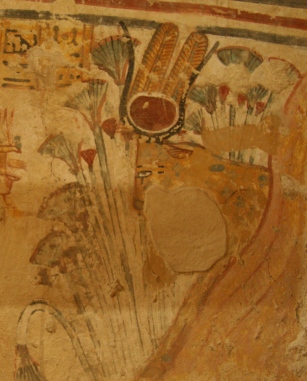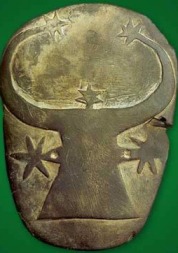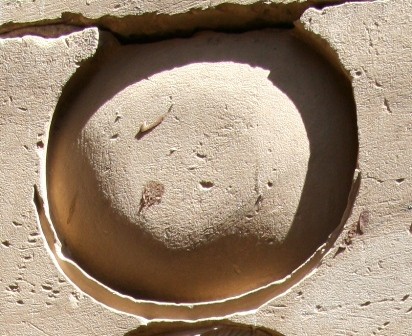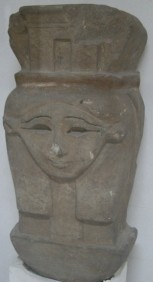The Coffin Texts mention a final shape of hair also with a deep symbolic meaning. It is the lock of hair s3mt. About the meaning of s3mt there are different opinions. According to A. Erman and H. Grapow s3mt means “sadness” [1]; A. Gardiner translates it as “mourning” [2] and for R.O. Faulkner its meaning is “lock of hair” [3]. We will treat that later and we will notice that all translations result in the same idea.
In chapter 334 of the Coffin Texts the deceased is Ihy[4], the son of Hathor[5], but he is also son of Re, Isis and Nephtys. In fact, many passages of the text refer to the dead one as a being in his first steps of existence. The chapter is very long, so we will skip a part of the text and will focus on the most interesting sentences for the subject we talk about:
“To change into Ihy…I am the first product of Re, he created me in the body of my mother Isis…
I am the son of Nephtys, I have been great and lucky.
My lock of hair s3mt is not destroyed in the bosom of my father and my mother.
I live, I exist…I am a protector. I am acclaimed in my name of Khonsu. I am immortal in the sky, with Re and my mother Hathor…”
His lunar nature comes from his condition as son of Re; he succeeds his father the sun, who rules the daily sky, in the sky during the night, the moonlight follows the sunlight. And we already know that the moon in Ancient Egypt is a symbol of new life in the Hereafter. The entire chapter is about the dead one as a new born, a son, he has the ability to be born with no handicaps, even his s3mt keeps intact and thanks to it, he can live and exist.
It is also interesting to notice that because the s3mt has not been destroyed the deceased exists and he is acclaimed in the name of Khonsu. This god was the son of Amon and Mut (Theban Triad) and his image characterized by the lunar head-dress and the side lock of hair[6]. Khonsu and his side lock were a symbol of youth and showed him as the heir[7]. Could we think of the s3mt as the side lock of Khonsu?

Khonsu with side lock and lunar head-dress. Relief from the funerary temple of Seti I in Dra Abu el-Naga. XIX Dynasty. Photo: Mª Rosa Valdesogo Martín.
If the lock of hair is synonymous with rebirth and inheritance; not destroy it would mean continuity and constant renovation. The dead one would be in the funerary thought of Ancient Egypt assimilated with Khonsu in the first step of the regeneration. Khonsu with the side lock (maybe s3mt) is the crescent, the childhood of the moon, and he starts its way to maturity; its growth for becoming the full moon, which materializes the deceased’s resurrection[8].
We have to take into consideration also the following passage:
“I am the ejaculated one, I crossed through her two legs…I have germinated in the egg, I have harried up through its sf[9], I have slid on its snf[10]. I am the lord of the blood…my mother Isis conceives me when she is unaware of her body under the fingers of the lord of the gods, who invades her that day of magnificence[11]…that day of disorder[12]… »
To keep the s3mt means to germinate into the egg, that vital centre which contains the energy to create a new being. The deceased remains inside the egg still unborn but and he will be reborn from it.
So, the lock of hair s3mt and the rebirth/regeneration appear together. Could we then think of that lock of hair s3mt as vital factor which helps the deceased in his resurrection? The answer seems to be affirmative[13].
[1] Wb IV, 18, 10.
[2] A. Gardiner, 1988, p. 588.
[3] R. O. Faulkner, 1988, p. 210.
[4] He is the musician with the sistrum.
[5] Already in Old Kingdom the deceased is “Horus, son of Osiris,…son of Hathor, the semen of Gueb” (Pyr., 466 a-b)
[6] J. Zandee, recalling Kees, who considered the lunar eye a parallel of the lock of hair (ZÄS 60), identified this one with Khonsu (J. Zandee, 1953, p. 112).
[7] Ph. Derchain, 1962, p. 40.
[8] In chapter 310 there are many verbs of growth, and that could be a proof of how the power of Khonsu increases (J. Zandee, 1953, p. 111)
[9] P. Barguet translates “egg white”.
[10] P. Barguet translates “yolk”, although its real meaning is “blood”.
[11] Could that refer to the sexual act?
[12] The translation of Xnnw is “uproar”, “disturbance” (Wb III, 383, 15). We are facing in this passage a moment of disorder, while the deceased is conceived; that shows the relationship we have already seen between chaos and orgy.
[13] As son of Isis the deceased is then also Horus and we will see later the relationship between this god and the lock of hair s3mt.













